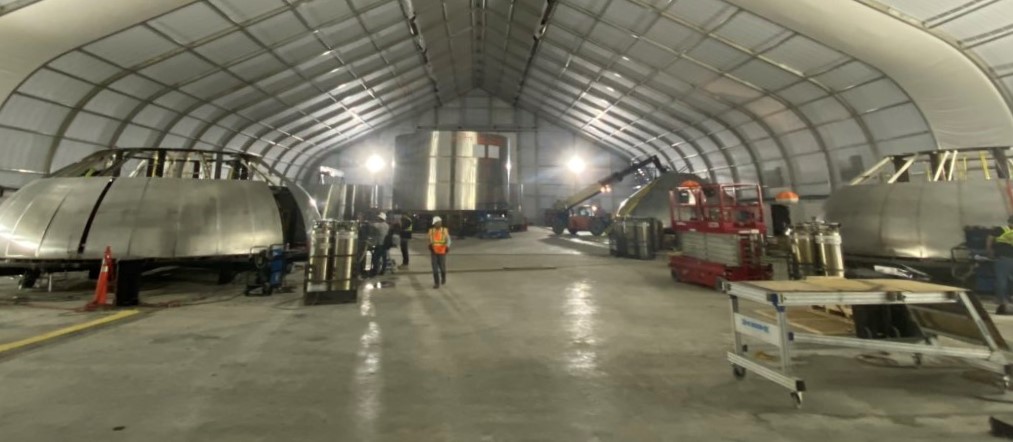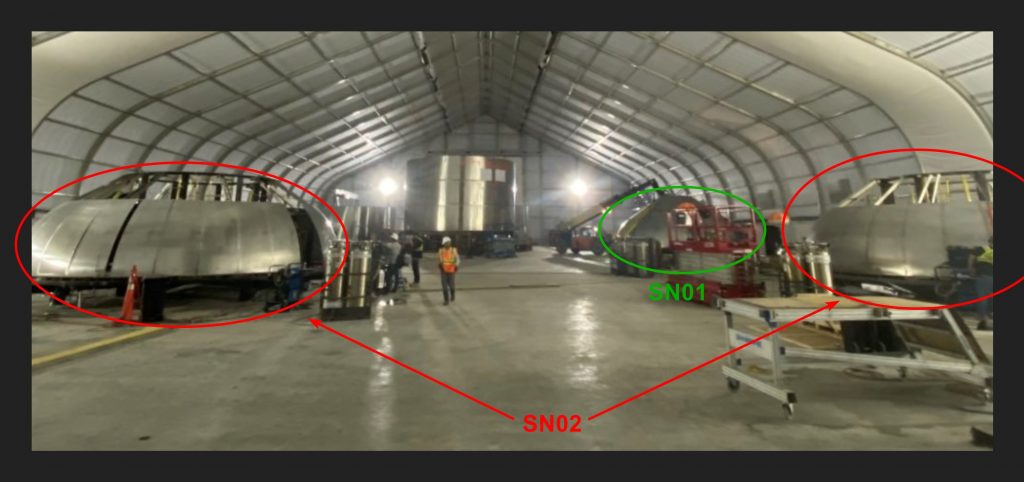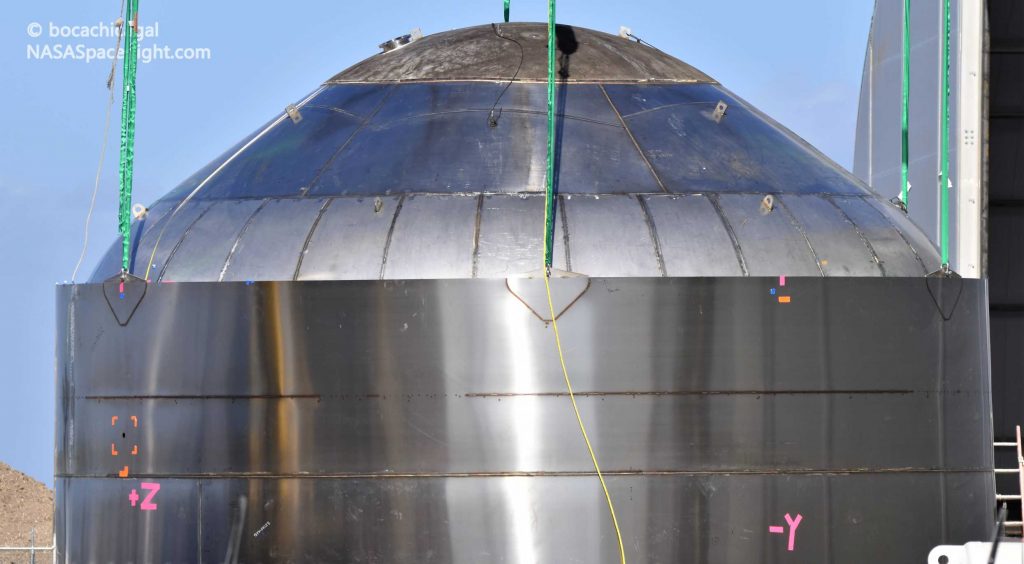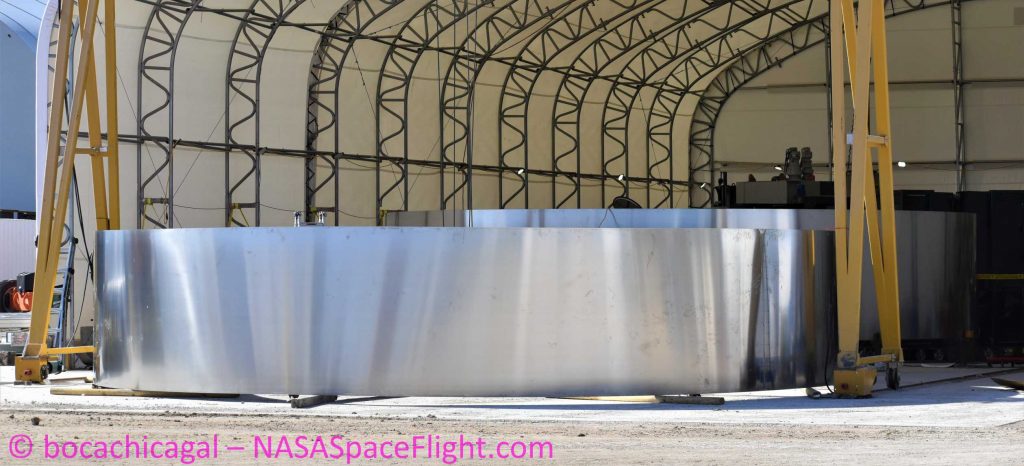

News
Elon Musk reveals SpaceX Starship production well underway inside new Texas factory
SpaceX CEO Elon Musk has offered a new glimpse inside the company’s rapidly-expanding South Texas Starship factory, revealing the beginnings of the next-generation rocket’s first true assembly line — and a wealth of spacecraft hardware.
Situated two or so miles from the Gulf of Mexico (and Mexico itself) in Boca Chica, Texas, SpaceX has been seriously planning a presence in South Texas for more than five years. Originally meant to host the United States’ first private orbital launch complex for Falcon 9 and Falcon Heavy rockets, only a small amount of work – known as soil surcharging – was done in the four years that followed SpaceX’s 2014 announcement. In late 2018, however, work began in earnest to build basic launch and manufacturing facilities.
Less than six months later, the first true Starship prototype – known as Starhopper and built from scratch out in the South Texas elements – ignited its Raptor engine for a brief static fire test, bringing the first to facilities and rocket to life less than half a year after they were little more than a pile of dirt and steel sheets. Now, barely nine months after Starhopper’s first static fire test, SpaceX is working around the clock to erect a full-scale rocket factory and build what could become the first orbital-class Starships. On February 9th, Elon Musk offered the best glimpse yet of the incredible progress SpaceX has made in a matter of weeks.
Barely a month ago, the rocket hardware pictured above did not exist, while the giant Tesla-inspired tent containing those Starship parts was a half-finished skeleton. Now, Elon Musk says that SpaceX has effectively completed three of the hardest parts of its first upgraded Starship prototype (SN01), while an additional two (of three) of those parts – known as propellant tank domes – are already in work for a second Starship (SN02).
Outside of the ‘sprung structure’ (i.e. tent) shown in Musk’s February 9th photo, SpaceX contractors appear to be just days away from completing the shell of a second identical tent, ultimately doubling the space available for enclosed manufacturing operations. At the same time as both Starship hardware and production facilities are rapidly coming together, SpaceX is also erecting what is presumed to be a Vehicle Assembly Building – a potentially massive structure that will protect vertical Starships and Super Heavy boosters from the elements while workers assemble them into finished rockets.


Inside the finished tent, SpaceX appears to have set up the first true Starship assembly line (of sorts), expanding from working on a single kind of prototype at a time to concurrent (serial) production of major components. Visible are three Starship bulkheads (tank domes) – two completed instances of which have already been transported outside and integrated with finished ring segments, forming two halves of Starship SN01’s complete liquid methane (LCH4) tank.
Near the back of the tent, work is also ongoing on several Starship SN01 tank rings. In the center, technicians are outfitting Starship SN01’s engine and ‘skirt’ section, where the bottommost tank dome will attach to three (up to six) Raptor engines. To the left, a stack of two rings appears to be stored off to the side, while – only slightly visible in Musk’s photo – another pair of rings is being welded together with the help of a rotating table.


Far from its full capacity and working out of a much smaller tent, SpaceX’s dedicated ringforming station – tasked with turning coils of steel into finished Starship rings – has finished no less than 34 steel rings since the January 1st. SpaceX is still clearly learning and at least third of those rings wound up being scrapped due to defects, but the material cost of all of those rings (~55 tons of steel) is probably less than $150,000. Additionally, those 34 completed segments would reach more than 60 meters (200 ft) tall if stacked, enough to build almost two Starship tank and engine sections – domes excluded.

In simple terms, SpaceX has pivoted away from the more boutique style of prototype fabrication used for Starhopper and Starship Mk1 and is now building Starship SNxx hardware extremely quickly. At the same time, the enclosed manufacturing space available to SpaceX is probably going to double before this week is out. Ultimately, SpaceX’s March 2020 Starship SN01 flight debut target is quickly becoming less and less crazy by the day.
Check out Teslarati’s Marketplace! We offer Tesla accessories, including for the Tesla Cybertruck and Tesla Model 3.

Elon Musk
Elon Musk and Tesla AI Director share insights after empty driver seat Robotaxi rides
The executives’ unoccupied tests hint at the rapid progress of Tesla’s unsupervised Robotaxi efforts.

Tesla CEO Elon Musk and AI Director Ashok Elluswamy celebrated Christmas Eve by sharing personal experiences with Robotaxi vehicles that had no safety monitor or occupant in the driver’s seat. Musk described the system’s “perfect driving” around Austin, while Elluswamy posted video from the back seat, calling it “an amazing experience.”
The executives’ unoccupied tests hint at the rapid progress of Tesla’s unsupervised Robotaxi efforts.
Elon and Ashok’s firsthand Robotaxi insights
Prior to Musk and the Tesla AI Director’s posts, sightings of unmanned Teslas navigating public roads were widely shared on social media. One such vehicle was spotted in Austin, Texas, which Elon Musk acknowleged by stating that “Testing is underway with no occupants in the car.”
Based on his Christmas Eve post, Musk seemed to have tested an unmanned Tesla himself. “A Tesla with no safety monitor in the car and me sitting in the passenger seat took me all around Austin on Sunday with perfect driving,” Musk wrote in his post.
Elluswamy responded with a 2-minute video showing himself in the rear of an unmanned Tesla. The video featured the vehicle’s empty front seats, as well as its smooth handling through real-world traffic. He captioned his video with the words, “It’s an amazing experience!”
Towards Unsupervised operations
During an xAI Hackathon earlier this month, Elon Musk mentioned that Tesla owed be removing Safety Monitors from its Robotaxis in Austin in just three weeks. “Unsupervised is pretty much solved at this point. So there will be Tesla Robotaxis operating in Austin with no one in them. Not even anyone in the passenger seat in about three weeks,” he said. Musk echoed similar estimates at the 2025 Annual Shareholder Meeting and the Q3 2025 earnings call.
Considering the insights that were posted Musk and Elluswamy, it does appear that Tesla is working hard towards operating its Robotaxis with no safety monitors. This is quite impressive considering that the service was launched just earlier this year.
Elon Musk
Starlink passes 9 million active customers just weeks after hitting 8 million
The milestone highlights the accelerating growth of Starlink, which has now been adding over 20,000 new users per day.

SpaceX’s Starlink satellite internet service has continued its rapid global expansion, surpassing 9 million active customers just weeks after crossing the 8 million mark.
The milestone highlights the accelerating growth of Starlink, which has now been adding over 20,000 new users per day.
9 million customers
In a post on X, SpaceX stated that Starlink now serves over 9 million active users across 155 countries, territories, and markets. The company reached 8 million customers in early November, meaning it added roughly 1 million subscribers in under seven weeks, or about 21,275 new users on average per day.
“Starlink is connecting more than 9M active customers with high-speed internet across 155 countries, territories, and many other markets,” Starlink wrote in a post on its official X account. SpaceX President Gwynne Shotwell also celebrated the milestone on X. “A huge thank you to all of our customers and congrats to the Starlink team for such an incredible product,” she wrote.
That growth rate reflects both rising demand for broadband in underserved regions and Starlink’s expanding satellite constellation, which now includes more than 9,000 low-Earth-orbit satellites designed to deliver high-speed, low-latency internet worldwide.
Starlink’s momentum
Starlink’s momentum has been building up. SpaceX reported 4.6 million Starlink customers in December 2024, followed by 7 million by August 2025, and 8 million customers in November. Independent data also suggests Starlink usage is rising sharply, with Cloudflare reporting that global web traffic from Starlink users more than doubled in 2025, as noted in an Insider report.
Starlink’s momentum is increasingly tied to SpaceX’s broader financial outlook. Elon Musk has said the satellite network is “by far” the company’s largest revenue driver, and reports suggest SpaceX may be positioning itself for an initial public offering as soon as next year, with valuations estimated as high as $1.5 trillion. Musk has also suggested in the past that Starlink could have its own IPO in the future.
News
NVIDIA Director of Robotics: Tesla FSD v14 is the first AI to pass the “Physical Turing Test”
After testing FSD v14, Fan stated that his experience with FSD felt magical at first, but it soon started to feel like a routine.

NVIDIA Director of Robotics Jim Fan has praised Tesla’s Full Self-Driving (Supervised) v14 as the first AI to pass what he described as a “Physical Turing Test.”
After testing FSD v14, Fan stated that his experience with FSD felt magical at first, but it soon started to feel like a routine. And just like smartphones today, removing it now would “actively hurt.”
Jim Fan’s hands-on FSD v14 impressions
Fan, a leading researcher in embodied AI who is currently solving Physical AI at NVIDIA and spearheading the company’s Project GR00T initiative, noted that he actually was late to the Tesla game. He was, however, one of the first to try out FSD v14.
“I was very late to own a Tesla but among the earliest to try out FSD v14. It’s perhaps the first time I experience an AI that passes the Physical Turing Test: after a long day at work, you press a button, lay back, and couldn’t tell if a neural net or a human drove you home,” Fan wrote in a post on X.
Fan added: “Despite knowing exactly how robot learning works, I still find it magical watching the steering wheel turn by itself. First it feels surreal, next it becomes routine. Then, like the smartphone, taking it away actively hurts. This is how humanity gets rewired and glued to god-like technologies.”
The Physical Turing Test
The original Turing Test was conceived by Alan Turing in 1950, and it was aimed at determining if a machine could exhibit behavior that is equivalent to or indistinguishable from a human. By focusing on text-based conversations, the original Turing Test set a high bar for natural language processing and machine learning.
This test has been passed by today’s large language models. However, the capability to converse in a humanlike manner is a completely different challenge from performing real-world problem-solving or physical interactions. Thus, Fan introduced the Physical Turing Test, which challenges AI systems to demonstrate intelligence through physical actions.
Based on Fan’s comments, Tesla has demonstrated these intelligent physical actions with FSD v14. Elon Musk agreed with the NVIDIA executive, stating in a post on X that with FSD v14, “you can sense the sentience maturing.” Musk also praised Tesla AI, calling it the best “real-world AI” today.








